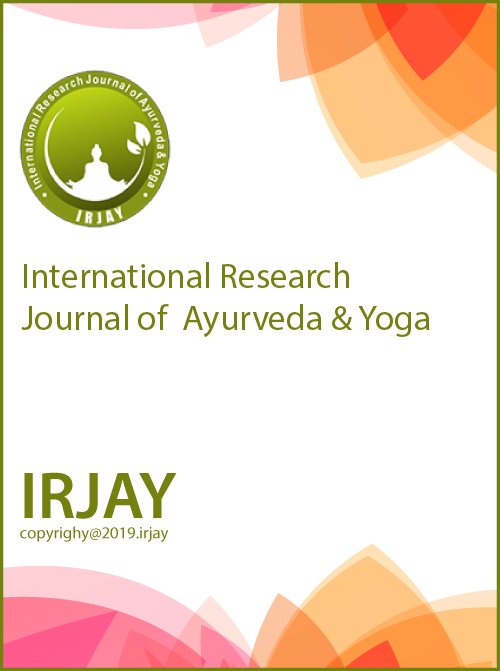Management of Mandala Kushtha through Shodhana Therapy: Case Study
DOI:
https://doi.org/10.48165/IRJAY.2025.80305Keywords:
Kushtha, Mandal Kushtha, Shodhana ChikitsaAbstract
Psoriasis, a chronic dermatological disorder, is characterized by erythematous lesions covered with silvery scales, significantly affecting patients’ physical and mental well-being. Its impact extends beyond cosmetic concerns, impairing quality of life. Conventional treatments for psoriasis often fail to provide a cure and may sometimes exacerbate symptoms. Globally, psoriasis accounts for 8% of dermatological cases, with an estimated prevalence of 2.5% and a male-to-female ratio of 1.1:1. This case report details the treatment of a 32-year-old male patient with a 3-year history of skin lesions on the scalp, upper back, and abdomen. The lesions were marked by red demarcations, silvery scaling, intense itching, and scales that detached with rubbing. Clinically, the condition was identified as Mandala Kushta, a subtype of Kushta in Ayurveda, characterized by raised patches (Utsana Mandalam), stability (Sthiram), hardness (Styanam), and whitish-red lesions (Shwetam Raktam). The patient underwent traditional Ayurvedic therapies, including Vamana Karma (therapeutic emesis) and Virechana Karma (therapeutic purgation), which were administered in line with classical principles for treating Kushta. Outcomes were evaluated using the Psoriasis Area and Severity Index (PASI) and photographic evidence taken before treatment, immediately after, and 2 months post-intervention. Following the therapy, there was a marked reduction in scaling, induration, and itching, with only hyperpigmented pink lesions remaining. Mandala Kushta, also referred to as Mahakushta, arises from the vitiation of Kapha dosha (Sleshma) and is associated with symptoms such as red spots, raised patches, itching, and burning sensations. Contributing factors include moisture-inducing diets (Kledakar Ahar), dosha imbalances (Dosha Vaishamya), channel obstructions (Srotavarodha), suppression of natural urges (Vegadharana), microbiological factors (Krimi), and psychological conditions (Manovikaras). The involvement of Tri-dosha, along with Rakta, Mamsa, and Twak, underscores the need for a holistic treatment approach. Clinical studies demonstrate that Shodhana Chikitsa, followed by Shamana Chikitsa, is more effective in managing psoriasis than either therapy alone. This case highlights the efficacy of Ayurvedic treatments, particularly Shodhana Chikitsa, in managing psoriasis.
Downloads
References
Psoriasis statistics and prevalence; (n.d). Available from: https:// www.psoriasis.org [Last asseed on 2024 Oct 10].
Easy Ayurveda. Characteristics of Mandala Kushta; (n.d.). Available from: https://www.easyayurveda.com [Last asseed on 2024 Oct 10]. 3. Bhati A, Yadav CR, Gurao R. Scope of ayurveda in the management of kushtha (skin diseases). Int Res J Ayurveda Yoga. 2024;7(4): 45-49. 4. Armstrong AW, Mehta MD, Schupp CW, Gondo GC, Bell SJ,
Griffiths CEM. Psoriasis prevalence in adults in the United States. JAMA Dermatol. 2021;157(8):940-6.
PubMed Central (PMC). Clinical evidence supporting Shodhana and Shamana therapies; (n.d.). Available from: https://www.pmc.ncbi. nlm.nih.gov [Last asseed on 2024 Oct 10].
Indian Dermatology. Epidemiological pattern of psoriasis vitiligo and atopic dermatitis in India: Hospital-based point prevalence. Indian Dermatol. 2014;5(5):6-8.
Shastri K. Charaka Samhita, Vidyotini Hindi commentary, Uttarardha, Chikitsasthan 7/41. Varanasi: Chaukhambha Bharati Academy; 2012.
Srivastav SJ. Sharangdhar samhita, hindi commentary, Madhyamkhanda 6/13-14. Varanasi: Chaukhambha Orientalia; 2005. 9. Shastri K. Charaka Samhita, Vidyotini hindi commentary, poorvardha, sutrasthan 22/10. Varanasi: Chaukhambha Bharati Academy; 2009. 10. Soni A, Sharma K, Mangal G. Effect of shodhana therapy in Mandala Kushtha (psoriasis): A case study. Res Rev J Unani Siddha Homeopathy. 2018;5(3):24-8.


